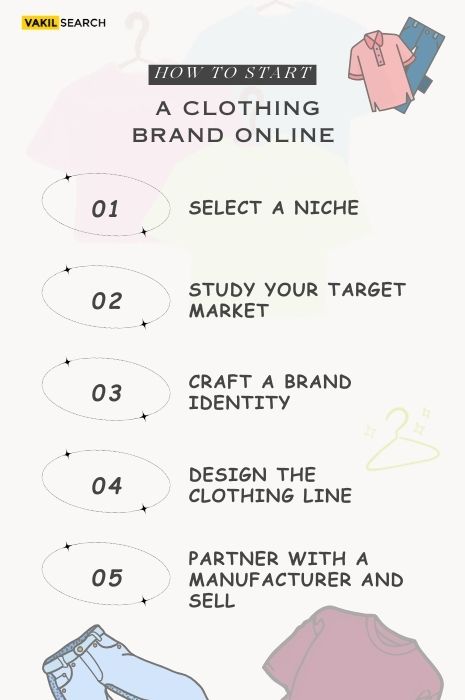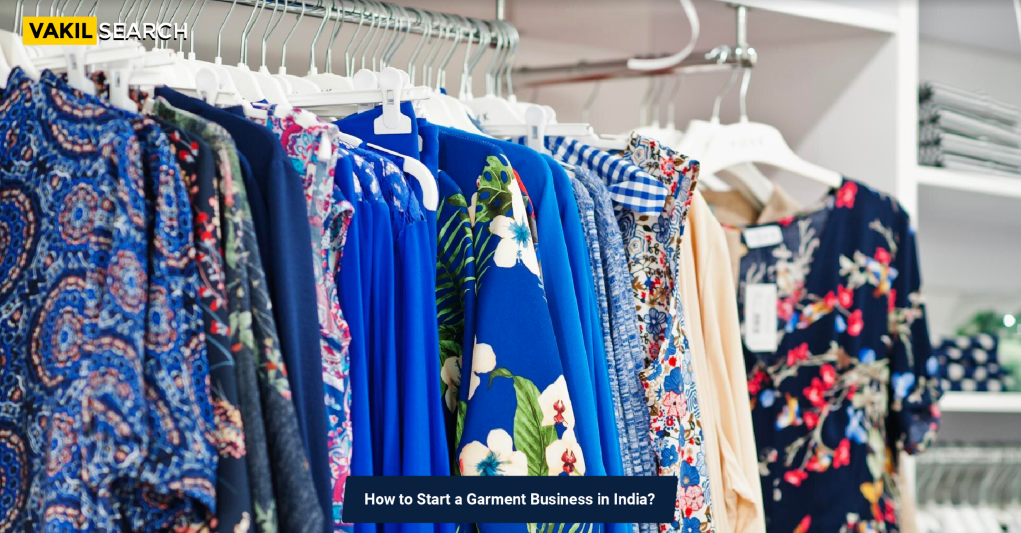Launching a garment business in India involves steps such as sourcing materials, creating appealing designs, and effective marketing. Read this complete guide
Garment Business in India – An Overview
The garment business in India is a dynamic and rapidly growing industry. It encompasses the design, production, and distribution of clothing and textiles. India’s diverse culture and rich tradition of textiles make it an attractive market for entrepreneurs. The sector offers various opportunities, from traditional clothing like sarees and ethnic wear to Western-style apparel. Success in this business requires a deep understanding of market trends, quality control, effective supply chain management, and marketing strategies to cater to a wide range of customer preferences. With the right approach, the Indian clothing business can be a profitable and rewarding venture.
How to Start a Clothing Brand?

To start a clothing brand, you will need to:
- Choose a niche: What type of clothing do you want to design and sell? Will you focus on a specific demographic, such as women’s clothing, menswear, or children’s clothing? Will you focus on a specific style, casual, streetwear, or formalwear?
- Research your target market: Once you have chosen a niche, you need to research your target market. Who are you selling to? What are their needs and wants? What are the current trends in the clothing industry?
- Develop your brand identity: Your brand identity is what will set you apart from other clothing brands. It includes your brand name, logo, and overall aesthetic.
- Design your clothing line: Once you have a strong brand identity, you can start designing your clothing line. This includes sketching out your designs, choosing fabrics and colours, and creating prototypes.
- Find a manufacturer and Market and sell your clothing: Once you have finalized your designs, you need to find a manufacturer to produce your clothing. You can find manufacturers online, through trade shows, or through your network of contacts. Once you have your clothing manufactured, you need to market and sell it. You can do this through your own website, social media, or through retail stores.
Is Garments Business Profitable?
Yes, the garment business can be profitable. The Indian garment industry is one of the largest in the world, and it is growing rapidly. However, it is important to note that the clothing business is also very competitive. To be successful, you need to have a strong understanding of the market and offer high-quality products at competitive prices.
Checklist for Starting a Garment Business
Here is a checklist for starting a clothing business:
- Choose a niche
- Research your target market
- Develop your brand identity
- Design your clothing line
- Find a manufacturer
- Market and sell your clothing
Start strong, register right now. Get Expert guidance for private limited company registration!

How to Start a Garment Shop in India?
To start a garment shop in India, you will need to:
- Do research on the readymade garment business: This includes understanding the market, the competition, and the latest trends.
- Create a detailed clothing business plan: This should include your business goals, strategies, and financial projections.
- Study the opportunities in the garment business: Identify the most profitable segments of the market and the best ways to reach your target audience.
- Be mindful of the infrastructure: You will need to find a suitable location for your garment shop and ensure that it is well-equipped.
- Select garment products and product range: Choose the right products for your target market and price them competitively.
- Find a place for the garment factory: If you plan to manufacture your own garments, you will need to find a suitable location for your factory.
- Estimate the garment production requirement monthly: This will help you to determine the number of machines and employees you will need.
- Estimate the manpower, machines and material requirements: This will help you to budget for your business.
- Estimate the investment requirement: This includes the cost of setting up your shop, purchasing inventory, and marketing your business.
- Raise money for the Project: You can raise money for your business through loans, investors, or crowdfunding.
- Customer development: Identify your target customers and develop strategies to reach them.
- Set up the clothing factory: If you plan to manufacture your own garments, you will need to set up your factory.
- Build your brand: Create a strong brand identity and promote your brand to potential customers.
- Promote your business: Market your business through various channels, such as advertising, social media, and public relations.
Starting a garment business can be a challenging but rewarding experience. By following the steps above, you can increase your chances of success.
Profitability of a Garment Business
The profitability of a garment business depends on a number of factors, including:
- The type of garments you sell
- The quality of your garments
- The price of your garments
- Your target market
- Your marketing and sales strategy
- Your overhead costs
If you can manage all of these factors effectively, you can build a profitable garment business.
Here are some tips for increasing your chances of success after making Garment company registration in india:
- Choose a niche. What type of garments do you want to sell? Will you focus on a specific demographic, such as women’s clothing, menswear, or children’s clothing? Will you focus on a specific style, such as casual, streetwear, or formalwear?
- Research your target market. Who are you selling to? What are their needs and wants? What are the current trends in the garment industry?
- Develop your brand identity. Your brand identity is what will set you apart from other clothing brands. It includes your brand name, logo, and overall aesthetic.
- Design your clothing line. Once you have a strong brand identity, you can start designing your clothing line. This includes sketching out your designs, choosing fabrics and colors, and creating prototypes.
- Find a manufacturer. Once you have finalized your designs, you need to find a manufacturer to produce your clothing. You can find manufacturers online, through trade shows, or through your network of contacts.
- Market and sell your clothing. Once you have your clothing manufactured, you need to market and sell it. You can do this through your own website, social media, or through retail stores.
It is also important to keep your overhead costs low. This means finding a good location for your business and negotiating good deals with your suppliers.
Garment Business FAQs
How to start a textile business at home?
Starting a textile business at home can be a viable option. Here are the steps to consider:
- Market Research: Identify your niche and target audience.
- Business Plan: Create a detailed business plan outlining your products, pricing, and marketing strategy.
- Legal Requirements: Register your business, if necessary, and obtain any required licenses or permits.
- Sourcing Materials: Find suppliers for fabrics and other materials.
- Production: Set up a workspace for cutting, sewing, and assembling garments.
- Quality Control: Ensure high-quality production and inspect products for defects.
- Marketing and Sales: Develop an online presence through a website or social media, and use e-commerce platforms for sales.
- Customer Service: Provide excellent customer service to build a loyal customer base.
- Scaling: As your business grows, consider expanding your product line or workspace.
How profitable is selling clothes?
The profitability of selling clothes depends on various factors, including market demand, pricing strategy, production costs, and competition. With the right planning, quality products, effective marketing, and efficient operations, selling clothes can be profitable. However, it's a competitive industry, so understanding your target market and staying adaptable is crucial.
How do I start my own shirt brand?
Starting your own shirt brand involves several steps:
- Design and Branding: Create unique shirt designs and establish your brand identity.
- Supplier and Material Sourcing: Find reliable suppliers for fabrics and materials.
- Production: Either manufacture the shirts yourself or outsource production.
- Quality Control: Ensure high-quality standards in production.
- Marketing: Develop a marketing strategy to promote your brand and products.
- Sales Channels: Choose sales channels such as e-commerce, physical stores, or both.
- Distribution: Set up a distribution network to reach customers.
- Customer Service: Provide excellent customer support.
- Legal Requirements: Register your brand, obtain necessary licenses, and protect your intellectual property.
Is the textile industry a good investment?
The textile industry can be a good investment, but it depends on various factors, including your expertise, market knowledge, location, and the specific niche within the textile industry you choose. The textile industry encompasses a wide range of products, from garments to industrial textiles, and can offer opportunities for growth and profitability.
What are the raw materials for garments?
Raw materials for garment production include:
- Fabrics: Various types of textiles, including cotton, silk, wool, polyester, and more.
- Thread: Used for stitching and sewing.
- Buttons and Fasteners: For closures and embellishments.
- Zippers: Used for fastening in clothing.
- Labels and Tags: For branding and information.
- Interfacing: Provides structure and support in certain garments.
- Elastic: Used in waistbands, cuffs, and other areas for flexibility.
- Trims and Accessories: Such as ribbons, lace, and appliques for decoration.
The specific materials you need will depend on the type of garments you plan to produce and the design elements involved in your clothing line.



